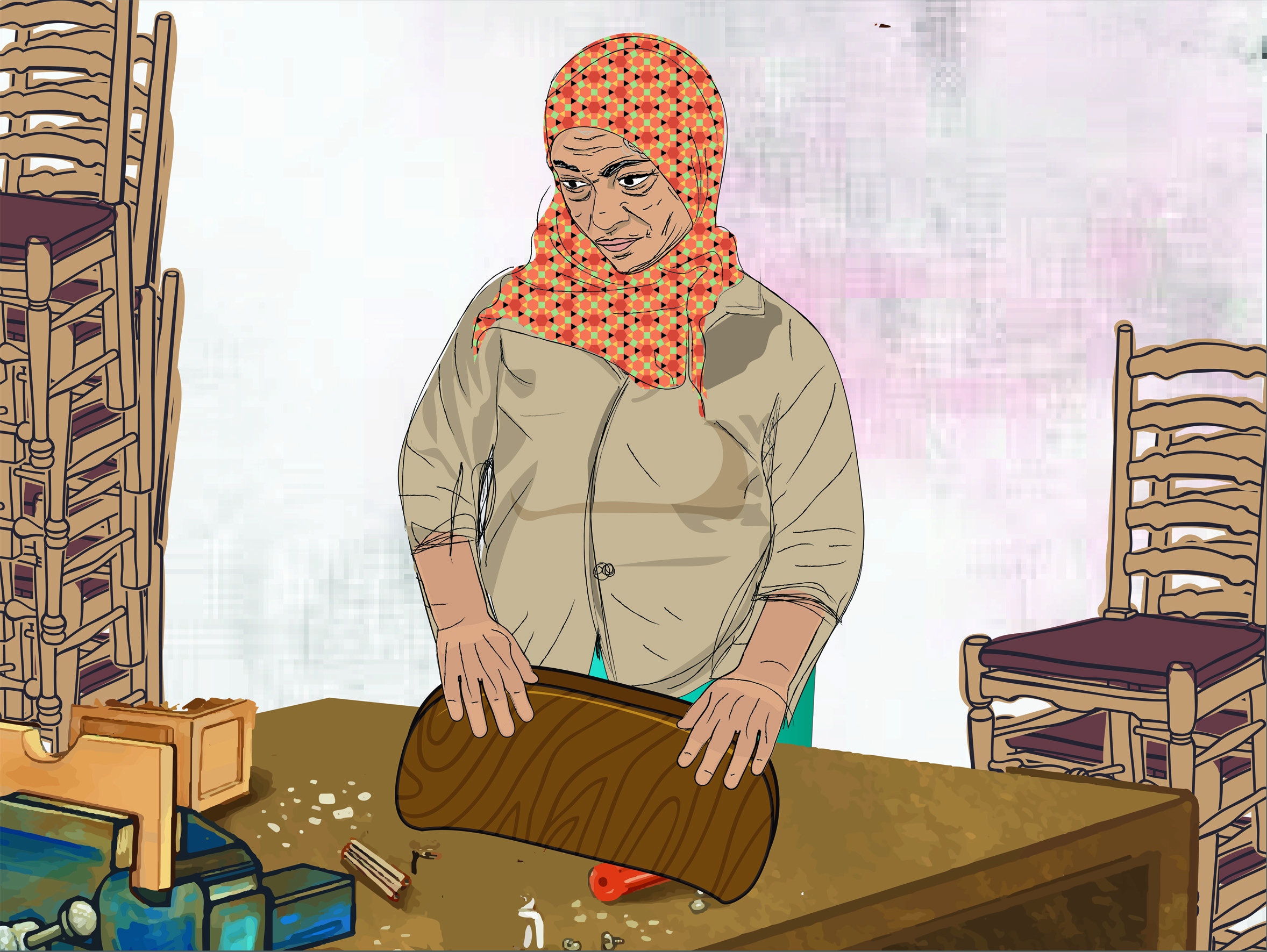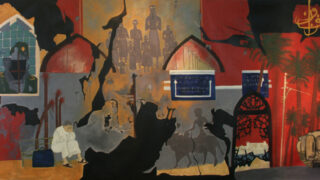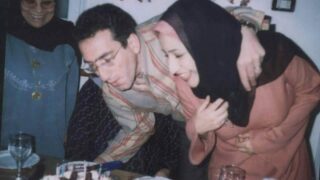
This publication has benefited from the support of the Rosa Luxemburg Foundation. This text may be reproduced in part or in full, provided the source is acknowledged.
From the vast valley along the river, thousands of families from Upper Egypt migrated to the outskirts of Cairo. They left their hometowns in the mid-nineteenth century to escape the exorbitant taxes imposed by the British occupation on agricultural land and settled at the foot of the Mokattam hills, where there was a vacant land and a newfound opportunity to dream.
Today, from the maze of the narrow alleyways, Umm Abdul Rahman ascends every morning towards the mountain. She and other women perform this daily journey, not as a leisurely hike leading up to the summit where they can see the sun, but to reach their workplace in the workshops scattered here and there, in the heart of the alleys and narrow streets that have been woven together over the years.
Manshiyyet Nasser: The rough life
The name of the area is Manshiyyet Nasser. Its official population is not less than 300,000 people, while unofficial statistics state twice that figure. This places the neighborhood in one of top ranks on the list of the most densely populated informal settlements in the African continent, according to the report entitled “Women and Men in the Informal Economy”, issued in 2013 by the International Labor Organization (ILO).
Ever since the migrants started arriving in the area, a community has been taking form; one with its own economic, cultural and social features, entrenched and bound by the conservative customs of Upper Egypt on the one hand and by the complications of Cairo’s poverty on the other hand.
It wasn’t until the early 1990s that the state started to become present in the area with the purpose of planning and development. Despite this, problems in infrastructure and services persisted, and the people of Manshiyyet Nasser- mainly the women – have taken it upon themselves to address the issues with tactics of circumvention and endurance. For instance, women take turns filling up water pitchers from the public taps to survive water cuts. As for the sewage system, despite all the local and international attempts for its development, 80 percent of the houses in the area remain dependent on underground reservoirs or "trenches" which are emptied through scavenger cars or carts pulled by donkeys.
Over the years, and as construction expanded, an evident contrast has been created within the large neighborhood which now includes no less than 8 residential areas. While massive buildings stand in some of those areas, small apartments scatter in others, where narrow rooms house a number of families that share one bathroom.
Furthermore, the health situation in the neighborhood is a direct reflection the difficult living conditions. According to the figures announced by the National Campaign for Newborn Health, infant mortality rate in Manshiyyet Nasser reaches 24% in infants one or less years old, whereas in other slum areas the rate does not exceed 8%. In addition, the neighborhood records high rates of chest and kidney diseases due to the population’s constant exposure to various kinds of exhausts and the lack of clean water.
Women workers endure repercussions
Naturally, understanding women’s conditions in particular can allow an all-encompassing view of everything happening in every corner of the neighborhood. The percentage of families with female breadwinners within the Egyptian society is continuously on the rise, reaching 30% according to estimates of the National Council for Children and Women’s Rights. In the expansive neighborhood of Manshiyyet Nasser, one of the most needy slum areas in the country, this percentage comes to 45%.
Part of them are women who are officially registered as widows, divorcees, or wives of incapacitated male providers, while a larger portion of them are those women whose faces are well-known in their community. They bear all responsibilities as the breadwinners of their families, even when they lack identification documents or governmental aid. They are those whose husbands have abandoned them or those who live with their jobless husbands (due to either illness or idleness) or with husbands who do small seasonal handyman gigs. There are also the girls for whom marriage becomes impossible if it were not for their ability to buy their own trousseau, without financially burdening their fathers with the expenses.
Women who can rely on some family support usually opt for the less onerous jobs at textile or plastic workshops for a daily wage of 30 to 40 EGP, while those burdened with heavier responsibilities take up the harsh types of “men’s work,” for a daily wage ranging between 60 to 90 EGP. Meanwhile, men doing the same work earn somewhere between 100 and 120 EGP.
In light of a crumbling educational system, most of the women in Manshiyyet Nasser can barely read and write, if at all, and young girls have access to basic or vocational education at best. A recent field survey by the National Center for Social and Criminological Research (NCSCR) has found that 62% of women in the Manshiyyet Nassser region have never been to school, while only 3.2% of women have a post-middle school education. For these women, the ideal choice appears to be finding work at one of the many unlicensed industrial workshops that spread throughout the neighborhood, which manufacture various materials such as textiles, plastic, aluminum, stainless steel, wood, and iron.
Stories of unfair wage
Women who have a financially supportive partner or family member usually opt for the less onerous jobs at clothing or plastic workshops, for a daily wage of 30-40 EGP, while those burdened with heavier responsibilities take up harsher types of work, usually classifies as “men’s work,” for a daily wage of 60-90 EGP. Meanwhile, men in the same jobs receive for the same work somewhere between 100 and 120 EGP.
Every day at nine in the morning, Umm Abdul Rahman joins a small squad of women inside the large “wood ward” where they work on sanding chairs. Their daily production target is already set at no less than 40 chairs each. The quotidian load leaves its mark on every worker’s clothes, face, and voice, with the permanent cloud of sawdust creeping into the air in their lungs for nine continuous hours, taking up most of their day and the early hours of their night.
Many others have also walked this route, including 15-year-old Rania, who already doesn’t see herself as a child, but rather an adult woman who is soon to get married. This dream, though, requires serious financial planning, which is why her mother made a decision she deems right for her daughter. For Rania, there was no escape from working at the workshop right after she finished elementary school. She works at the piston press, making stainless steel heaters in a workshop that employs 7 men and young girls who all line up behind the machine that presses raw material into a mold of the required shape. Rania is no longer afraid of the monstrous machine or the loud sounds it makes. However, she does worry when she can’t afford to deduct part of her salary to buy hand creams and face moisturizers that can help her fix some stubborn hyperpigmentation, or Melasma, that have developed on her skin due to the nature of her work.
Production hazards and motives
The numerous workshops in the area are in a way part of its identity. The migrants who had settled there have taken up the craft of collecting and recycling solid materials to produce cheap building materials. As the slum area expanded, some government infrastructure services were connected to it, and so a number of hazardous workshops, such as aluminum and plastic workshops, were removed from Cairo’s center and set up in Manshiyyet Nasser instead. Approximately 65% of all economic activity in that region is linked to these essential crafts, and it has become a common sight that the first floor in most of the houses is a small workshop or an appendage to a big workshop.
The statistics of the State’s Social Research Center on work trends in Manshiyyet Nasser reveal that handicrafts rank first with 33.6%, while freelance work reaches 20.5%. The percentage of self-employment is 39.4%, while those employed by other make up 47.8% of workers.
A small squad of women works inside the large “wood ward,” sanding chairs. Their daily target production is set at no less than 40 chairs each. This load leaves its mark on every worker’s clothes, face, and voice, with the permanent cloud of sawdust creeping into the air in their lungs for nine hours straight, taking up most of their day and the early hours of their night.
In 2015, the residents of the area, in an attempt to legalize their work, established the Manshiyyet Nasser Workshop Owners Association. They submitted the required documents to the Ministry of Trade and Industry in order to obtain commercial registers and allow for the legal regulation of workshop workers and government oversight. However, their applications have not much moved forward since, other than the successive meetings held on the matter and the periodic collection of taxes. The association is promised that each case would be studied individually so it can be decided whether to legalize a business or transfer it to a location outside the residential area, as the president of the association Yasser Abul Ola confirms.
Nonetheless, one of the major outcomes of this civil work is the completion of a preliminary inventory of the present workshops and their employees. According to Abul Ola, the number of operating workshops has reached 1,200 spread across the valley (in addition to a large number of other workshops on the hill that do waste collection and recycling). The number of workers in one workshop ranges between 10 and 40 male and female workers, and according to the association’s estimates, no less than 2,000 women are employed in such workshops in Manshiyyet Nasser.
Although the type of craftsmanship at the workshops certainly requires a special kind of skill and experience on the part of the men and women workers alike, the job is still largely dependent on a daily wage basis. Labour law, social security, and health insurance systems for workers are simply nonexistent in those space, and there is a total lack of all occupational safety standards. Work injuries or illnesses are subject to customary assessments and aid as a form of solidarity compensation.
Stories of burnout
Throughout our brief conversation, Umm Abdul Rahman was always aware of the meaning of her persistent cough, but she preferred to shake it off with her relentless “Alhamdulillah, praise be to God always.” And “always” includes all the times she was at the mercy of the many health risks of the constant exposure to air laden with sawdust.
According to the occupational health and safety guidelines issued by the World Bank for small industries, workers in furniture and wood product workshops must wear face masks and gloves at all times to avoid exposure to fine particles produced by the manual sanding of furniture.
Alternatively, workshops may rely on machination, which means that workers like Umm Abdul Rahman would lose their jobs to the machines, or otherwise continue to endure the health risks… and the coughs.
“I have a sick husband at home,” she says, “He has water in his lungs because he used to work with aluminum. The only compensation we got was allowing me to work in a big wood factory. My son is married and can’t find stable work, so he lives with us too. I boil some herbs every day before I go to bed and drink the brew for my cough. I usually feel better afterwards, and I get some rest on my weekly day off.”
Rania is 15 years old and is soon to be married. Her dream requires serious financial planning, so there was no escape from working at the workshops right after she finished elementary school. She works at the piston press, making stainless steel heaters, in a workshop that employs 7 men and young girls who all line up behind a big machine that presses raw material into a mold.
What Umm Abdul Rahman describes with clear, simple words actually suggests much more serious and severe health disasters at the workplace. Just like her husband, other men and women are exposed to the dangers of aluminum presses and waste recycling, which expose all workers in those workshops to dangerous gases, such as propane, methane and ethane, all of which are harmful to lungs and toxic to blood. Workers are also at risk of being caught in fires, where an unintended spark in these gas-saturated places surrounded by residential homes can turn into a catastrophe, as these factories lack the most basic safety equipment, i.e. smoke detectors and fire alarms.
According to health reports, working in the manufacture of aluminum, plastic, and wood has health consequences on the respiratory system and lung tissues in the medium term. Many countries, including Egypt, have banned women and children from working at such factories, in compliance with international labor conventions, but the ban is a mere formality. The harm these women register on their own bodies becomes a regular part of the job; so normal that most of them return my questions about this issue with laughter and an exchange of skeptical looks. At one moment, however, as she was leading me to the door after our interview ended, a tearful Umm Abdul Rahman said, “Life is full of suffering, and so we suffer and endure pain. It doesn’t matter whether I work with aluminum, wood, or copper.”
Attempts at change
Mona Al-Gammal, the Executive Director of the Youth and Women's Welfare Association, brought our attention to an important approach. In an exclusive interview with Assafir Al-Arabi, she told us the story of one of her colleagues; a woman in her forties who worked as a cleaning lady for years at the association. The woman obtained a divorce on account of being the victim of increasing violence at her husband’s hands, after which she found herself carrying the full responsibility for providing for her three children. Her husband failed to take any responsibility, leaving them high and dry as a kind of revenge for the divorce. It was right then that she decided to look for a job in one of the men's workshops, as they called it, where work was physically demanding. She now earns 350 EGP a week from her daily shift at the piston press machine, and she gets one weekly day off.
She refuses to admit just how much her health has suffered from the job, while she remains fearful that her children might drop out of school because of her absence from home for long hours. According to Al-Gammal, this woman’s story can be linked to some other outcomes of women’s unregulated work in sectors outside the State’s development plans. “Girls are allowed to go out to work” can be used as a justification within families to adhere to the practice of female genital mutilation, as young girls are the “workers of the future,” and so they are “circumcised to protect their moral integrity.”
Unfortunately, the association was unable to fulfill the role it had hoped to play in the poor neighborhood when it first set out ten years ago. Manshiyyet Nasser witnessed the implementation of a large number of development projects supported by international or non-governmental donors, especially during the 1990s, including projects by the German Development Agency (GIZ) and the Egyptian-Swiss Development Fund (ESDF). These projects focused on connecting clean water networks and sewage systems, installing street lighting, and building health centers and primary schools.
However, the political and societal changes over the past twenty years have surely had negative effects on the situation. According to statements by MP Mona Jaballah, who represents the electoral district of Manshiyyet Nasser, the number of active civil society organizations that have been integrated into the national social initiative “A Dignified Life” is 30 associations whose activities focus on providing in-kind support, medical treatment, and scholarships for children. However, unlike the kind of civil activity that was predominant in the 1990s, this new type of social work rarely ever meets the needs of the region.
Men and women are exposed to the dangers of aluminum presses and waste recycling, which expose all workers in those workshops to dangerous gases, such as propane, methane and ethane, all of which are harmful to lungs and toxic to blood. Workers are also at risk of being caught in fires, as these factories lack the most basic safety equipment, i.e. smoke detectors and fire alarms.
The amendments to the Civil Associations Law in the recent years have limited the cooperation of international donors to government institutions directly. This has obstructed many developmental roles that some associations and NGOs in the region had succeeded in achieving after years of work. On the other hand, the collapse of Al-Duwayqa Rock (a horrific incident that happened in Manshiyyet Nasser in 2009 and claimed the lives of 500 people) scared away many international institutions, which stopped funding after the incident revealed the lack of seriousness and the omnipresent corruption and manipulation in the management of re-housing projects and plans of the equitable distribution of opportunities.
“Most of the women come to us requesting the same thing,” Al-Gammal says, “which is to obtain a soft loan in order to help set up a small business, such as buying and selling clothes or dairy products. But most NGOs no longer have sufficient funds for vocational training activities or loans. In addition, the high inflation rates have hit the markets hard, and small projects can no longer make their desired margins of profit. Every woman who thinks of getting a loan for her private project is haunted by the prospect of a criminal conviction, which is why most women opt for work at the workshop. A bird in one’s hand is worth ten in the bush, although in this case, the ‘bird’ keeps them drained…”
Precarious labour inhabits the peripheries
The bleakness of the situation is much clearer to those looking at it from the outside, especially when the living conditions of an informal residential area, whose inhabitants have become accustomed to the daily suffering, are compared to and overlapped with the general conditions across the country over time. Precarious labour, and its heavy dependence on women, has become a constant in Egypt.
Tens of thousands of women along the Nile’s Delta work agricultural lands. Others are street vendors on the sidewalks of markets or workers at textile and clothing factories. Many carry bricks and construction materials and others work on heavy machines in workshops, recycling steel and raw materials.
A recent report by the ILO entitled “The gender gap in employment: What's holding women back?” notes that the proportion of men in the workforce in Egypt is 76%, while that of women does not exceed 23%. However, the report notes that the issue does not lie with women’s registered low employment rate, but with the fact that the bulk of women’s work is in precarious and unstable jobs, in which they lack fair financial returns and labour rights.
The report indicates that 66% of these women do not receive maternity protection in cases of pregnancy and childbirth, and that precarious labour includes not only informal work and unfair wages, but also partly or fully unpaid work in many cases where women work for free in family projects or with relatives. The report recommended enacting laws and activating oversight to ensure equal pay and address occupational discrimination between men and women.
The content of this publication is the sole responsibility of Assafir Al-Arabi and Rosa Luxemburg Foundation cannot accept any liability for it.
Translated from Arabic by Sabah Jalloul
Published in Assafir Al-Arabi on 11/02/2020







